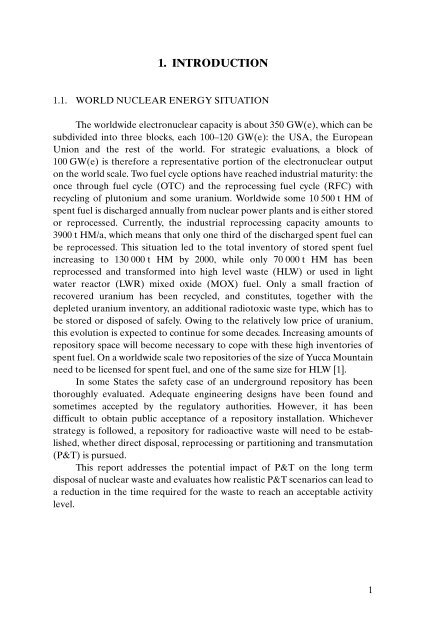TRS435_web
TRS435_web
TRS435_web
You also want an ePaper? Increase the reach of your titles
YUMPU automatically turns print PDFs into web optimized ePapers that Google loves.
1. INTRODUCTION<br />
1.1. WORLD NUCLEAR ENERGY SITUATION<br />
The worldwide electronuclear capacity is about 350 GW(e), which can be<br />
subdivided into three blocks, each 100–120 GW(e): the USA, the European<br />
Union and the rest of the world. For strategic evaluations, a block of<br />
100 GW(e) is therefore a representative portion of the electronuclear output<br />
on the world scale. Two fuel cycle options have reached industrial maturity: the<br />
once through fuel cycle (OTC) and the reprocessing fuel cycle (RFC) with<br />
recycling of plutonium and some uranium. Worldwide some 10 500 t HM of<br />
spent fuel is discharged annually from nuclear power plants and is either stored<br />
or reprocessed. Currently, the industrial reprocessing capacity amounts to<br />
3900 t HM/a, which means that only one third of the discharged spent fuel can<br />
be reprocessed. This situation led to the total inventory of stored spent fuel<br />
increasing to 130 000 t HM by 2000, while only 70 000 t HM has been<br />
reprocessed and transformed into high level waste (HLW) or used in light<br />
water reactor (LWR) mixed oxide (MOX) fuel. Only a small fraction of<br />
recovered uranium has been recycled, and constitutes, together with the<br />
depleted uranium inventory, an additional radiotoxic waste type, which has to<br />
be stored or disposed of safely. Owing to the relatively low price of uranium,<br />
this evolution is expected to continue for some decades. Increasing amounts of<br />
repository space will become necessary to cope with these high inventories of<br />
spent fuel. On a worldwide scale two repositories of the size of Yucca Mountain<br />
need to be licensed for spent fuel, and one of the same size for HLW [1].<br />
In some States the safety case of an underground repository has been<br />
thoroughly evaluated. Adequate engineering designs have been found and<br />
sometimes accepted by the regulatory authorities. However, it has been<br />
difficult to obtain public acceptance of a repository installation. Whichever<br />
strategy is followed, a repository for radioactive waste will need to be established,<br />
whether direct disposal, reprocessing or partitioning and transmutation<br />
(P&T) is pursued.<br />
This report addresses the potential impact of P&T on the long term<br />
disposal of nuclear waste and evaluates how realistic P&T scenarios can lead to<br />
a reduction in the time required for the waste to reach an acceptable activity<br />
level.<br />
1


